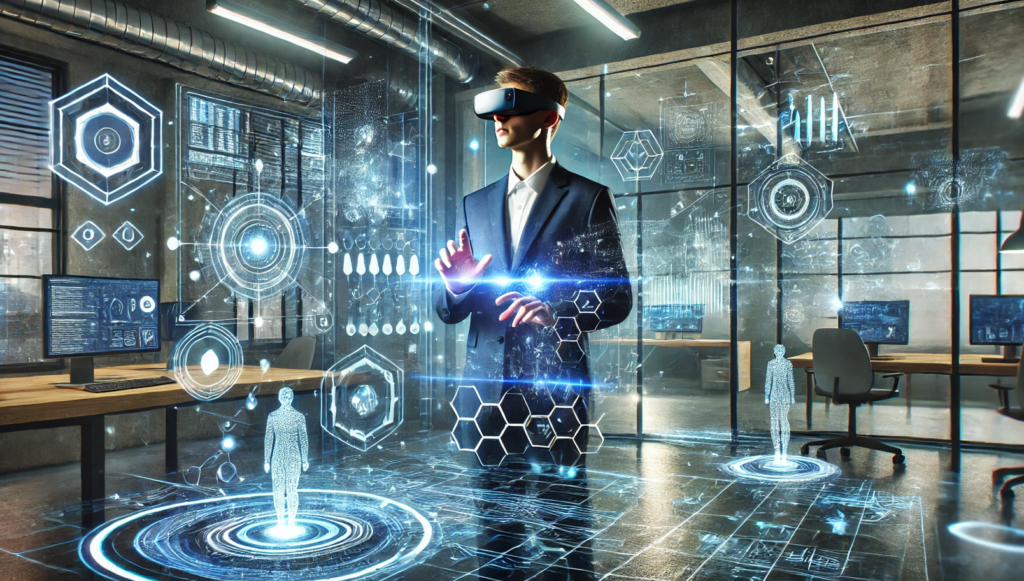The design landscape is evolving faster than ever, fueled by advancements in technology, shifting consumer preferences, and the global push for sustainability.
What took years to advance in the late 2010’s is now progressing in a matter of weeks with the advent of widespread AI technologies.
As we approach 2025, businesses must embrace cutting-edge design techniques to stay competitive and relevant.

Here’s a look at the key design trends shaping the future and how businesses can leverage them effectively.
- Immersive Design: Merging Physical and Digital Worlds
With the rise of augmented reality (AR), virtual reality (VR), and mixed reality (MR), immersive design is no longer a novelty—it’s a necessity. These technologies allow brands to create engaging, interactive experiences that blur the line between the digital and physical worlds.
How to Embrace It:
Leverage AR/VR for Customer Engagement: Retailers can use AR to let customers visualize products in their space before buying. Real estate companies can use VR for virtual property tours.
Invest in Training and Tools: Equip your design teams with AR/VR tools and training to experiment with immersive solutions.
Incorporate Gamification: Use interactive, game-like features in your digital platforms to engage users more effectively. - AI-Driven Personalization
Artificial intelligence is revolutionizing how businesses approach design. By analyzing user behavior and preferences, AI can help create hyper-personalized designs that resonate deeply with individual consumers.
How to Embrace It:
Dynamic Websites: Implement AI algorithms that adjust website layouts, content, and product recommendations in real-time.
Chatbot Integration: Use AI-powered chatbots with personalized interfaces that match customer profiles.
Data-Driven Insights: Use analytics to understand user patterns and design more intuitive and predictive interfaces. - Sustainable and Minimalist Design
Sustainability is at the forefront of consumer consciousness, pushing brands to adopt eco-friendly design principles. Minimalism, with its focus on simplicity and functionality, complements this trend by reducing waste and promoting clarity.
How to Embrace It:
Eco-Friendly Materials: For product design, prioritize sustainable materials and processes.
Minimalist Aesthetics: Streamline user interfaces and physical products to focus on essential elements, reducing visual clutter.
Transparent Branding: Highlight your commitment to sustainability through storytelling and clear, honest communication in design. - Inclusive and Accessible Design
As the global conversation around inclusivity grows, businesses must prioritize designs that cater to a diverse audience, including individuals with disabilities.
How to Embrace It:
Accessibility Standards: Follow guidelines like the Web Content Accessibility Guidelines (WCAG) to ensure digital platforms are usable by everyone.
Diverse Representation: Incorporate diverse cultural, gender, and ability perspectives in your visual and content design.
User Testing: Conduct regular usability testing with individuals from varied demographics to identify and address accessibility gaps. - Dynamic Branding
Static, one-size-fits-all branding is becoming obsolete. The future belongs to brands that can adapt their identity to different platforms, contexts, and audiences without losing their core essence.
How to Embrace It:
Flexible Logos: Design logos and brand assets that can morph in style or format while retaining recognizability.
Platform-Specific Content: Tailor design elements to fit the unique demands of platforms like TikTok, Instagram, or emerging social spaces.
Interactive Branding: Use dynamic elements like animations, responsive visuals, or live updates to make your branding more engaging. - Emotional and Human-Centered Design
In an era dominated by technology, creating emotional connections is more crucial than ever. Human-centered design, which focuses on empathy and understanding user needs, will define successful brands in 2025.
How to Embrace It:
Story-Driven Content: Incorporate storytelling in your design to foster emotional connections with users.
Empathy Mapping: Use empathy maps during the design process to deeply understand your audience’s needs, pain points, and desires.
Design for Well-Being: Consider designs that promote mental health, reduce stress, or foster positive emotions. - The Rise of 3D and Motion Graphics
Static visuals are giving way to dynamic 3D designs and motion graphics that provide a richer, more engaging user experience.
How to Embrace It:
3D Product Visuals: Use realistic 3D renders for product showcases, particularly in e-commerce.
Motion Design: Integrate animations and transitions in websites, apps, and advertising to captivate users.
Interactive Prototypes: Use 3D and motion tools to create interactive prototypes for client presentations or user testing. - Ethical Design and Data Privacy
As data breaches and privacy concerns grow, ethical design practices are becoming a top priority for businesses. Designs must respect user data and prioritize transparency.
How to Embrace It:
Simplified Consent: Use clear, non-deceptive interfaces for data collection and privacy options.
Ethical AI: Ensure AI-driven designs do not exploit user vulnerabilities or biases.
Privacy by Design: Incorporate data protection into the design process rather than treating it as an afterthought.
The future of design is as much about technology and aesthetics as it is about values and human connection.
Businesses that proactively adopt these techniques will not only keep pace with emerging trends but also build stronger relationships with their customers.

By focusing on immersive experiences, personalization, sustainability, inclusivity, and ethical practices, companies can create designs that are not just functional but also meaningful.
As 2025 approaches, the question is not whether to embrace modern design trends, but how quickly and effectively your business can integrate them to lead in the future.